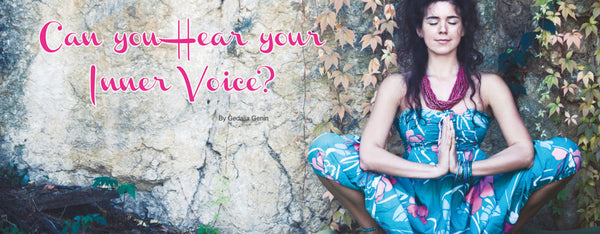Can you Hear your Inner Voice?
Posted on March 21 2018

Much has been written on the spiritual path about the “soft voice” or “inner voice” that Ayurveda describes as the “Self” or the “True Self.” In a way, these inner messages are similar to the texts or instant messages we receive from friends and family. One difference is you don’t need an iPhone or Android cell phone to receive an inner message; those promptings are unfolding all the time. Yes, each of us can tune into such inner messages. It’s helpful to remember that the language of the Self is infinitely varied, and may take the form of words, a sign, a signal, a message from strangers, child, dog, cat, coworker, a vision, an impulse or strong intuitive feeling that is trying to get our attention. The question is: Is anyone listening? Are you paying attention? Do you discount such messages? How do you know if it is indeed the voice of the inner Self? What distracts us or gets in the way?
Ayurveda helps us to uncover and discover the “truth” of who we are. Its practices help us to find balance on all levels of our being so that we can remember who we are, and return to an inner awareness of wholeness. To heal, according to Ayurveda, is to regain memory of one’s Self, one’s wholeness – not through an approach of fixing broken parts. Emotions – sadness, grief, anxiety, worry, fear – can hijack or state and dull us to the possibility of inner guidance. If our mind is racing or we’re in a state of high stress, then it’s all that much harder to tune into the inner murmurings of the Self.
This is why the practices of meditation, prayer and yoga that build our faith, strength, and even humor, are so necessary. If we live in a state of distraction, we’re blind to life’s miracles, especially the infinite ways grace and love manifest in our daily lives. Love and serenity truly are always present. Our effort is to be able to tune into it to listen for love, to notice beauty and serenity.
At the heart of Ayurveda is the practice of “meditation”. Perhaps more than any other pursuit this is a pathway to tune into and hear the quiet still voice and dip beneath the chatter, judgments, and thoughts that cloud the mind. However, sometimes the fruit of meditation may not be inner calm – it may take the form of enthusiasm.
In Sanskrit, the word is spanda means vibration or throb – and is a cosmic impulse arising from the heart. A spanda can open new doors, move us out of inertia or dullness into a more awakened existence. It was spanda that led me to learn Marma. It was a spanda that inspired me to paint and work with color and healing. Too often we wait for a huge sign from the universe when often the sign may be as simple as a happy inclination, like a child who spontaneously leaps up to skip or jump.
Here are three simple ways to access your inner voice and experience spanda or an inner flash of awareness:
- Pause – a simple, momentary stop in action can be helpful before we speak or when we’re trying to make a decision. Cultivate the patience to choose when it feels right instead of racing to act. Recognize that overthinking and worry may only cloud your clarity. See the value in freeing your mind from the congestion of overthinking.
- The breath is always a good friend. Simply hearing the soft whisper of your own breath is an excellent pathway to stillness. While taking a breath try to look in the other person’s eyes and really see them and let yourself be seen.
- Trust your body and learn its signals. Fatigue, digestive issues, headaches or overwhelm might simply just need your compassionate awareness. Following your gut reaction rather than what your mind might be telling you is always a healthy practice.
It takes trust and courage to listen to the inner Self – to the guidance and flow that is naturally present within. Your inner awareness is there beckoning you home to this greatest source of inner wisdom.
Author: Gedalia Genin
Naturopath Ayurvedic Health Specialist “Profound change one woman at a time." www.gedaliahhealingarts.com

